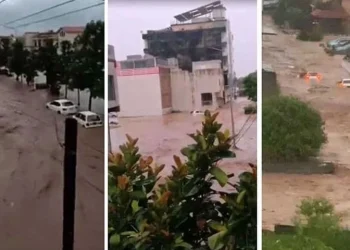Monsoon rains during Eid-ul-Azha in Karachi, Pakistan’s largest city, have wreaked havoc. Heavy rains have incapacitated the city’s low-lying areas and major highways, disturbing life.
According to the report, 14 people have so far died in various accidents due to monsoon rains in Karachi.
Rains in the country
According to figures released by the National Disaster Management Authority (NDMA), the monsoon has so far killed 147 people across the country in a month, including 88 women.
The highest death toll from the rains was 63 in Balochistan province. While the death toll in Sindh is reported to be 26, 14 deaths occurred in Karachi, 9 in Thatta, 2 in Khairpur, and one in Sukkur. According to rescue sources, most of the deaths were due to electric shocks, drownings, roof collapses, and accidents.
Rains flood situation in Karachi
According to the report of the Meteorological Department, the rains in Karachi from July 4 to 11 have broken the record of all the rains in an average of one monsoon in a single spell.
According to the Meteorological Department, the highest rainfall so far was recorded in Defense Phase II at 342.4 mm. 324.6 at Masroor Base, 280.5 at Faisal Base, 251 at Gulshan-e-Hadid, 213 at Landhi, 203 at Nazimabad, 203 at Observatory Area Airport, 180 at North Karachi, 153.7 at North Terminal, 110 at Jinnah Terminal, 196 at Surjani Town and 127 at Orangi Town. The architect recorded 105 mm of rain.
Regarding the situation in the city, Sindh Chief Minister Murad Ali Shah while talking to the media said that relief work could not be done as long as it continued to rain. Work can be done only when the rains stop. The natural drainage which was closed with time is being drained from the existing ones. At the moment all the staff and missionaries are busy in the city and soon the roads will be cleaned with rainwater.
He said that most areas and highways of Karachi have been cleared with the help of city administration, army, and civil institutions since Monday but still according to local media reports Old City Area, Clifton Underpasses, and Defense have accumulated water which has increased the hardships of the people living there.
It should be noted that in the areas of the city where drainage has not been possible, there has been no electricity for several hours on which K-Electric is of the view that they can fix the power lines only in case of a shortage of water.
Rain emergency declared in Karachi
The Sindh government had on Monday declared a ‘rain emergency’ in Karachi. Water seeped into people’s homes due to flooding of drains in different parts of the city including Korangi and Orangi. Several feet of water remained standing in Defense, Clifton, Napa Chowrangi, Shahra-e-Faisal, and Qayyumabad Chowrangi.
The blame game
Leaders of political parties are blaming each other for the devastation caused by the rains in Karachi. Waseem Akhtar, leader of Muttahida Qaumi Movement (MQM), told a press conference yesterday that the province has had a PPP government for many years but still, the city has no personnel.
Wasim Akhtar alleged that the city administrator and other officials had gone inside Sindh to celebrate Eid and that Karachi was sinking.
On the other hand, Pak Sarzamin Party chief Syed Mustafa Kamal said in a press conference that Karachi feeds the whole of Pakistan but does not pay any attention to it.
In addition, a meeting was held under the chairmanship of Sindh Chief Minister Syed Murad Ali Shah in which the Sindh Chief Minister directed the Karachi Water Board to immediately draw water from all the roads of the city.
Instructing the officials, the Sindh Chief Minister said that the roads damaged due to rains should be repaired immediately.
Alarming situation
The Meteorological Department, while issuing a high alert, said that there was a severe low pressure in eastern India which would enter Sindh coming from Rajasthan, and then again heavy rains would lead to urban flooding.
According to the Meteorological Department, this spell could lead to flood situations in Karachi, Thatta, Badin, Hyderabad, Umerkot, Jamshoro, Dadu, Mirpur Khas, Larkana, and Sukkur.
Sardar Sarfraz says the problems could be exacerbated if the rains from Kirthar and other mountain ranges do not find a place. Due to the recent rains, there is no more capacity in Hub Dam at this time.
Was there a warning about torrential rains?
According to the Meteorological Department, a notification was issued in the first week of June that heavy rains are expected across the country from July to September, which could lead to floods.
The Meteorological Department said that we had warned that the catchment area of the Indus, Jhelum, and Chenab rivers could be flooded due to rains. Regarding the rains in Sindh and Karachi, the Sindh government and concerned agencies were also given a forecast of what the coming monsoon would be like.
Who is responsible?
According to experts, Karachi has been under the control of the Sindh government for 35 years, which is doing nothing but filling its pockets. The Sindh government is fully responsible for the destruction of Karachi.
Experts say that whichever government comes to power does not pay any attention to Karachi while Karachi is the highest revenue earning city in the country which is also called Mini Pakistan, but its condition is less than any village Goth. No, the higher authorities try to be acquitted only by tweeting or announcing money for the victims while they have an even bigger responsibility.
According to experts, they should review the performance of the provincial government to see if it is working to solve the city’s problems.































